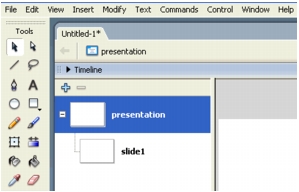


 |   |
In Macromedia Flash MX Professional 2004, screens provide an authoring user interface with structural building blocks that make it easy for you to create complex, hierarchical Flash documents, such as slide presentations or form-based applications.
Screens provide high-level containers for creating applications. With screens, you can structure complex applications in Flash without using multiple frames and layers on the main Timeline. In fact, you can create a complex application without viewing the main Timeline at all.
When you author a screen-based document, the screens are arranged in a structured hierarchy that you create. You structure the document by nesting screens in a branching tree. You can easily preview and modify the structure of a screen-based document.
You can create screen-based documents of two different types: a Flash Slide Presentation, suitable for sequential content such as a slide show or multimedia presentation, or a Flash Form Application, ideal for nonlinear, form-based applications, including Rich Internet Applications. Screen-based documents can be saved in Flash Player 6 format or later only, not in any earlier Flash Player format.

Detail of default workspace for a new Flash Slide Presentation. Screen thumbnails appear in the Screen Outline pane on the left side of the workspace, and the Timeline is collapsed.
  | |